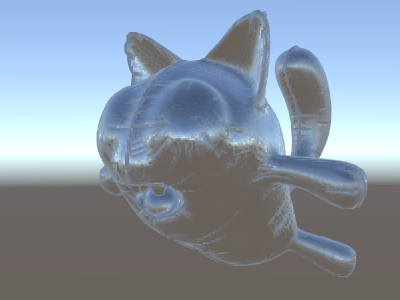内置渲染管线中的法线贴图着色器示例

通常使用 法线贴图一种凹凸贴图纹理,允许您为模型添加表面细节,例如凹凸、凹槽和划痕,这些细节会像真实几何体那样捕获光线。
请参阅 术语表 来在对象上创建额外的细节,而无需创建额外的几何体。让我们看看如何创建一个 着色器在 GPU 上运行的程序。 更多信息
请参阅 术语表 来反映环境,并使用法线贴图纹理。
现在数学开始变得非常复杂,所以我们将分几个步骤进行。在上面的着色器中,反射方向是在每个顶点(在顶点着色器中)计算的,而片段着色器只执行反射探针的 立方体贴图六个方形纹理的集合,可以表示环境中的反射或几何体后面绘制的天空盒。六个方格形成一个包围对象的虚拟立方体的面;每个面表示沿世界轴方向(向上、向下、向左、向右、向前和向后)的视图。 更多信息
请参阅 术语表 查找。但是,一旦我们开始使用法线贴图,表面法线本身就需要在每个像素的基础上进行计算,这意味着我们还必须计算环境的每个像素的反射方式!
我们还需要学习一个新东西,即所谓的“切线空间”。法线贴图纹理通常在可以认为是“遵循模型表面”的坐标空间中表达。在我们的着色器中,我们需要知道切线空间基向量,从纹理中读取法线向量,将其转换到世界空间,然后执行上面着色器中的所有数学运算。让我们开始吧!
Shader "Unlit/SkyReflection Per Pixel"
{
Properties {
// normal map texture on the material,
// default to dummy "flat surface" normalmap
_BumpMap("Normal Map", 2D) = "bump" {}
}
SubShader
{
Pass
{
CGPROGRAM
#pragma vertex vert
#pragma fragment frag
#include "UnityCG.cginc"
struct v2f {
float3 worldPos : TEXCOORD0;
// these three vectors will hold a 3x3 rotation matrix
// that transforms from tangent to world space
half3 tspace0 : TEXCOORD1; // tangent.x, bitangent.x, normal.x
half3 tspace1 : TEXCOORD2; // tangent.y, bitangent.y, normal.y
half3 tspace2 : TEXCOORD3; // tangent.z, bitangent.z, normal.z
// texture coordinate for the normal map
float2 uv : TEXCOORD4;
float4 pos : SV_POSITION;
};
// vertex shader now also needs a per-vertex tangent vector.
// in Unity tangents are 4D vectors, with the .w component used to
// indicate direction of the bitangent vector.
// we also need the texture coordinate.
v2f vert (float4 vertex : POSITION, float3 normal : NORMAL, float4 tangent : TANGENT, float2 uv : TEXCOORD0)
{
v2f o;
o.pos = UnityObjectToClipPos(vertex);
o.worldPos = mul(_Object2World, vertex).xyz;
half3 wNormal = UnityObjectToWorldNormal(normal);
half3 wTangent = UnityObjectToWorldDir(tangent.xyz);
// compute bitangent from cross product of normal and tangent
half tangentSign = tangent.w * unity_WorldTransformParams.w;
half3 wBitangent = cross(wNormal, wTangent) * tangentSign;
// output the tangent space matrix
o.tspace0 = half3(wTangent.x, wBitangent.x, wNormal.x);
o.tspace1 = half3(wTangent.y, wBitangent.y, wNormal.y);
o.tspace2 = half3(wTangent.z, wBitangent.z, wNormal.z);
o.uv = uv;
return o;
}
// normal map texture from shader properties
sampler2D _BumpMap;
fixed4 frag (v2f i) : SV_Target
{
// sample the normal map, and decode from the Unity encoding
half3 tnormal = UnpackNormal(tex2D(_BumpMap, i.uv));
// transform normal from tangent to world space
half3 worldNormal;
worldNormal.x = dot(i.tspace0, tnormal);
worldNormal.y = dot(i.tspace1, tnormal);
worldNormal.z = dot(i.tspace2, tnormal);
// rest the same as in previous shader
half3 worldViewDir = normalize(UnityWorldSpaceViewDir(i.worldPos));
half3 worldRefl = reflect(-worldViewDir, worldNormal);
half4 skyData = UNITY_SAMPLE_TEXCUBE(unity_SpecCube0, worldRefl);
half3 skyColor = DecodeHDR (skyData, unity_SpecCube0_HDR);
fixed4 c = 0;
c.rgb = skyColor;
return c;
}
ENDCG
}
}
}
呼,这太复杂了。但是,看看,法线贴图反射!